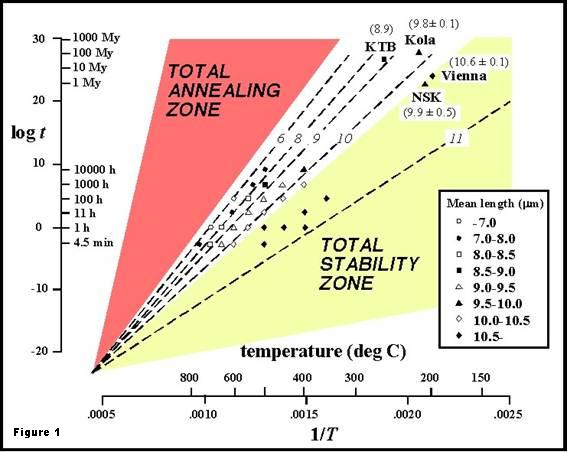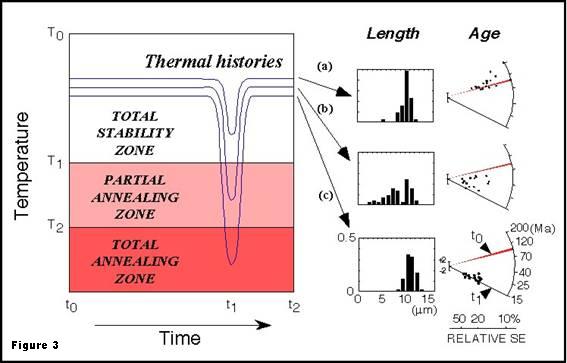

| Fission-Track Thermochronology of Zircon A series of laboratory studies of temperature-dependent track retention in zircon has been conducted in the last decade, using confined spontaneous track lengths as a measure of annealing, as well as etched track widths for standardization of track revelation (Tagami et al., 1990, 1998; Yamada et al., 1993, 1995a,b, 1998; Hasebe et al., 1994). As a result of this research, kinetic parameters that describe FT annealing at laboratory time scales have been established for zircon (Yamada et al., 1995b, Galbraith and Laslett, 1997; Tagami et al., 1998). The fanning model formula for the mean length (mu) after annealing at temperature T Kelvin for time t hours is given by (Tagami et al., 1998): |
| mu = 11.35[1 - exp{-6.502 + 0.1431(ln t + 23.515)/(1000/T – 0.4459)}] |
| Samples from deep boreholes have provided additional constraints on the FT annealing behavior in zircon on geological timescales (Vienna Basin, Austria, Tagami et al., 1996; Kola, Russia, Green et al., 1996; KTB-HB, Germany, Coyle and Wagner, 1996; MITI-Nishikubiki, Japan, Hasebe et al., 2003). Figure 1 summarizes the results of the annealing experiments and the borehole sample studies. The validity of extrapolating the kinetic model to geological timescales is supported by the consistency between the model extrapolations and borehole constraints (Tagami et al., 1998; Figure 1). In addition, the mineral parageneses and quartz microstructures of high pressure – low temperature rocks on Crete, Greece, indicate that the higher temperature limit of the zircon partial annealing zone (PAZ) is between 350° and 400°C for a heating duration of 4 ± 2 Ma (Brix et al., 2002). This constraint is consistent with the model extrapolation within errors. The zircon FT closure temperature directly calibrated from 40Ar/39Ar diffusion of K-feldspar and biotite is about 260° – 265°C and about 235°C for cooling rates of 30 – 50°C/my and about 4°C/my, respectively (Foster et al., 1996). Furthermore, Hurford (1991) estimated the zircon FT closure temperature to be 230±25 °C for a cooling rate of 30°C/my based on the cooling curve of Alpine metamorphic rocks that had been dated by apatite FT (with a closure temperature of 100-120 °C), biotite K-Ar and Rb-Sr (with closure temperatures of about 300 °C) as well as zircon FT method. These estimated temperatures are both within the zircon PAZ based on the extrapolation of the kinetic model to geological timescales (Figure 1; see also Tagami et al., 1996, and Brandon et al., 1998, for evaluation and compilation of other available data). |
 |
Track annealing properties of zircon have also been constrained through the FT analysis of thermal perturbation around a granitic pluton (Tagami and Shimada, 1996) (Figure 2). These data come from the contact metamorphic aureole in the Cretaceous Shimanto Belt, southwest Japan, formed by the intrusion of the Takatsukiyama Granite at 15 Ma, for which the heating duration is estimated as about 105 – 106 years using a one dimensional heat conduction modelling (Tagami and Shimada, 1996). Figure 2a presents the relationship between sample-mean zircon FT ages and their surface (two-dimensional) distances from the intrusion contact of the Takatsukiyama granite (Tagami and Shimada, 1996). The ages are generally similar to or older than Cretaceous depositional ages for samples >4 km away from the contact. Approaching the contact, however, the ages show a continuous reduction from about 100 to 15 Ma at about 3 km distance. They coincide with the zircon FT ages of the Takatsukiyama Granite (15.0 ± 0.4 Ma) for localities <2.5 km from the contact. Figure 2b shows representative examples of single-grain age distributions using radial plots (Galbraith, 1990) and track-length histograms. Track-length distributions (Figure 2b) show variations consistent with increasing resetting due to the heating at 15 Ma. In unreset samples, track lengths show a unimodal distribution and average about 10 mm Approaching the contact, samples that experienced the thermal effects of the pluton intrusion were significantly annealed and shortened, thus yielding a bimodal distribution with a greater number of tracks <9 mm in length. Less than 2.5 km from the contact, thermal resetting is complete due to higher paleotemperatures, and the samples have a unimodal distribution of long tracks formed after the 15 Ma event. The mean lengths in un-annealed or totally annealed (reset) samples are close to the reference value of 10.5 ± 0.1 mm determined for zircon age standards from rapidly cooled volcanic rocks (Hasebe et al. 1994). |
 |
Figure 3 illustrates a schematic relationship among; (i) three temperature zones that approximately express the thermal stability of the zircon FT system, i.e., total stability zone, partial annealing zone and total annealing zone; (ii) three hypothetical thermal histories characterized by secondary heating to different paleo-maximum temperatures; and (iii) three sets of length and age distributions resulted from the three different time-temperature pathways. Using this relationship, we can inversely reconstruct the thermal history of rocks from measured FT length and age data (for quantitative analysis, see Gallagher et al., 1998). Here we note that the boundary temperatures (i.e., T1 and T2 in Figure 3) for the three temperature zones substantially vary with heating time duration, as shown in Figure 1. This variation in PAZ boundaries should be kept in mind when we analyze a heating phenomenon that has duration significantly shorter (<1 My) than the ordinary geological timescales (1-1000 My), the former of which may be the case of thermochronology of fault zones. |
 |
| These lines of evidence suggest that the zircon FT system nicely quantifies the thermal history of rocks in nature. FT investigations of rocks from fault zones require consideration of two factors that are worth special consideration. First, fault rocks may have been subjected to hydrothermally-pressurized conditions at some stage during fault development. To evaluate this factor, laboratory heating experiments of zircon were carried out using a hydrothermal synthetic apparatus (Brix et al., 2002; Yamada et al., 2003). For reliable comparison, Yamada et al. (2003) annealed the same zircon samples, using the same temperature monitor and experimental procedure as those employed in the previous experiment at atmospheric conditions (Yamada et al., 1995b). The observed FT annealing characteristics are indistinguishable between the heating carried out at atmospheric and hydrothermally-pressurized conditions. This probably validates the application of annealing kinetics based on the experiments at atmospheric conditions to rocks subjected to hydrothermal conditions in nature, such as those in fault zone and plate subduction settings. Second, frictional heating along a fault is a short-term phenomenon with heating durations on the order of seconds, significantly shorter than the conventional laboratory heating having durations of about 0.1 to 10000 hours. Thus, high-temperature and short-term annealing experiments were newly designed and conducted using a graphite furnace coupled with infrared radiation thermometry (Murakami et al., in prep.). Their results show that the observed track length reduction by 3.6 - 10 sec heating at 599° – 912°C is similar to that predicted by the FT annealing kinetics based on the conventional laboratory heating for 4.5 min – 10000 hr at 350° – 750 °C (Yamada et al., 1995b; Tagami et al., 1998). In addition, it was found that spontaneous FTs in zircon are totally annealed at 850º ± 50ºC for about 4 seconds. These physical conditions are similar to those of some pseudotachylyte formation in nature (e.g. Otsuki et al., 2003, for pseudotachylyte of the Nojima fault). (All figures after Tagami and Murakami, AAPG memoir, in press) |
| REFERENCES Brandon, M. T., M. K. Roden-Tice, and J. I. Garver, 1998, Late Cenozoic exhumation of the Cascadia accretionary wedge in the Olympic Mountains, northwest Washington State: Bulletin of Geological Society of America, v. 110, p. 985-1009. Brix, M. R., B. Stockhert, E. Seidel, T. Theye, S. N. Thomson, and M. Kuster, 2002, Thermobarometric data from a fossil zircon partial annealing zone in high pressure-low temperature rocks of eastern and central Crete, Greece: Tectonophysics, v. 349, p. 309-326. Coyle, D. A., and G. A. Wagner, 1996, Fission-track dating of zircon and titanite from the 9101 m deep KTB: observed fundamentals of track stability and thermal history reconstruction: Abstract of presentation at International Workshop on Fission Track Dating, Gent, Belgium. Foster, D. A., B. P. Kohn, and A. J. W. Gleadow, 1996, Sphene and zircon fission track closure temperatures revisited; empirical calibrations from 40Ar/39Ar diffusion studies of K-feldspar and biotite, in International Workshop on Fission Track Dating, Gent 1996: University of Gent, Gent, p. 37. Galbraith, R.F., 1990, The radial plot: Graphical display of spread in ages: Nuclear Tracks, v. 17, p. 207-214. Galbraith, R. F., and G. M. Laslett, 1997, Statistical modeling of thermal annealing of fission tracks in zircon: Chemical Geology (Isotope Geoscience Section), v. 140, p. 123-135. Gallagher, K., R. Brown, and C. Johnson, 1998, Fission track analysis and its applications to geological problems: Annual Review of Earth Planetary Sciences, v. 26, p. 519-572. Green, P. F., K. A. Hegarty, I. R. Duddy, S. S. Foland, and V. Gorbachev, 1996, Geological constraints on fission track annealing in zircon: Abstract of presentation at International Workshop on Fission Track Dating, Gent, Belgium. Hasebe, N., N. Mori, T. Tagami, and R. Matsui, 2003, Geological partial annealing zone of zircon fission-track system: additional constraints from the deep drilling MITI-Nishikubiki and MITI-Mishima: Chemical Geology, v. 199, p. 45-52. Hasebe, N., T. Tagami, and S. Nishimura, 1994, Towards zircon fission-track thermochronology: Reference framework for confined track length measurements: Chemical Geology (Isotope Geoscience Section), v. 112, p. 169-178. Hurford, A. J., 1991, Uplift and cooling pathways derived from fission track analysis and mica dating: a review: Geologische Rundscau, v. 80, p. 349-368. Otsuki, K., N. Monzawa, and T. Nagase, 2003, Fluidization and melting of fault gouge during seismic slip: Identification in the Nojima fault zone and implications for focal earthquake mechanisms: Journal of Geophysical Research, v. 108(B4), p. 2192, doi:10.1029/2001JB001711. Tagami, T., and C. Shimada, 1996, Natural long-term annealing of the zircon fission track system around a granitic pluton: Journal of Geophysical Research, v. 101, p. 8245-8255. Tagami, T., A. Carter, and A. J. Hurford, 1996, Natural long-term annealing of the zircon fission-track system in Vienna Basin deep borehole samples: constraints upon the partial annealing zone and closure temperature: Chemical Geology, v. 130, p. 147-157. Tagami, T., R. F. Galbraith, R. Yamada, and G. M. Laslett, 1998, Revised annealing kinetcs of fission tracks in zircon and geological implications, in P. Van den haute, and F. De Corte, eds., Advances in fission-track geochronology: Kluwer academic publishers, Dordrecht, The Netherlands, p. 99-112. Tagami, T., H. Ito, and S. Nishimura, 1990, Thermal annealing characteristics of spontaneous fission tracks in zircon: Chemical Geology (Isotope Geoscience Section), v. 80, p. 159-169. Yamada, K., T. Tagami, and N. Shimobayashi, 2003, Experimental study on hydrothermal annealing of fission tracks in zircon: Chemical Geology, in press. Yamada, R., T. Tagami, and S. Nishimura, 1993, Assessment of overetching factor for confined fission track length measurement in zircon: Chemical Geology (Isotope Geoscience Section), v. 104, p. 251-259. Yamada, R., T. Tagami, and S. Nishimura, 1995a, Confined fission-track length measurement of zircon: assessment of factors affecting the paleotemperature estimate: Chemical Geology (Isotope Geoscience Section), v. 119, p. 293-306. Yamada, R., T. Tagami, S. Nishimura, and H. Ito, 1995b, Annealing kinetics of fission tracks in zircon: an experimental study: Chemical Geology (Isotope Geoscience Section), v. 122, p. 249-258. Yamada, R., T. Yoshioka, K. Watanabe, T. Tagami, H. Nakamura, T. Hashimoto, and S. Nishimura, 1998, Comparison of experimental techniques to increase the number of measurable confined fission tracks in zircon: Chemical Geology (Isotope Geoscience Section), v. 149, p. 99-107. |